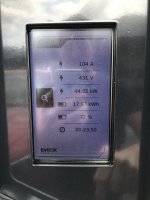D
Deleted member 2439
Guest
Essentially the losses will be inside the charger, but I’d wager that the unit displays consumed AC power. They certainly ain’t going to give you something for nothing!That’s an interesting thought you’ve raised.
I had assumed that when on a DC charger, the power (kWh) shown on the chargers was what had been supplied to the car (in DC) not what the charger had/was consuming in AC.
Some Googling to be done here....
